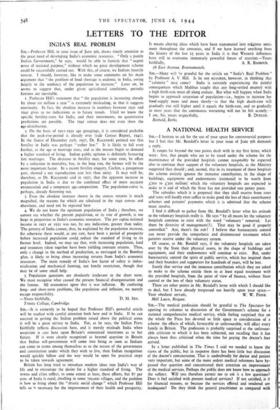INDIA'S REAL PROBLEM
LETTERS TO THE EDITOR
Sta,—Professor Hill, in your issue of June 9th, draws timely attention to the great need of developing India's economic resources. " Only a purely Indian Government," he says, would be able to furnish that " urgent sense of national purpose," without which no great development scheme could be successfully carried out. With this, of course, we Indians heartily concur. I should, however, like to make some comments on his main argument that " the problem of food shortage is endemic in India, owing largely to the tendency of the population to increase." Later on, he seems to suggest that, under given agricultural conditions, periodic famines are inevitable.
1. Professor Hill's statement that " the population is increasing already by about six million a year " is extremely misleading, in that it suggests continuity. In fact, the absolute increase in numbers between ][931 and 1941 gives us no indications as to future trends. Until we know the specific fertility-rates for India, and their movements, no quantitative predictions are possible. The 1941 census does not even show the age-distribution.
2. On the basis of 1911-1931 age groupings, it is considered probable that the peak-rise-period is already over (vide Census Report, 1941). In the Statist of December 25th, 1937, Dr. Kuczynski pointed out that fertility in India was perhaps " rather low." It is likely to fall even further, as the age at marriage rises, and as the masses begin to demand a higher standard of living. Indian public opinion is definitely favouring late marriages. The decrease in fertility may, for some time, be offset by a reduction in mortality, but, in the long run, the former will be the more important factor. In a recent fertility enquiry, Cochin, a prosperous part, showed a net reproduction rate less than unity. It may well be, therefore, as Dr. Kuczynski said in 1937, that the apparent increase in population in India is due to the combined effect of more accurate enumeration and a temporary age-composition. The population-cuive is, perhaps, already flattening out.
3. Even the absolute inorease shown in the census returns is much magnified, the reasons for which are tabulated in the 1941 census and elsewhere, and need not be repeated here 4. We do not know the optimum population of India ; therefore, we cannot say whether the present population, or its rate of growth, is too large in proportion to India's economic resources. The per capita national income in 1921 or 1931 was not, by any indication, greater than today. The poverty of India cannot, thus, be explained by the population increase, for otherwise there would, at any rate, have been a period of prosperity before increased population could, reduce the standard of living to its former level. Indeed, we may say that, with increasing population, land and resources taken together have been yielding constant returns. Thus, only a change in the method of production, as envisaged in the Bombay plan, is likely to bring about increasing returns from India's economic resources. The main remedy of India's low factor of safety is indus- trialisation and mechanical farming, not family restriction, though that may be of some small help.
5. Population questions are absolutely irrelevant in the short term. We must recognise what caused the present financial disorganisation and the famine. All economists agree that it was inflation. By confusing long- and short-term problems, like population and inflation, we merely escape responsibility.


























 Previous page
Previous page